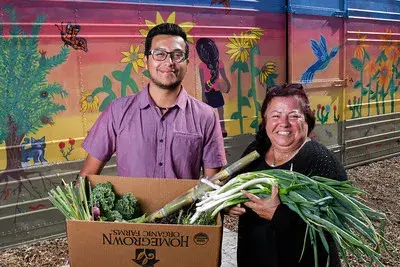Farm Service Agency and Organic Agriculture
Organic farmers, ranchers, and food processors follow a defined set of standards to produce

organic food and fiber. Congress described general organic principles in the Organic Foods Production Act, and the USDA defines specific organic standards. These standards cover the product from farm to table, including soil and water quality, pest control, livestock practices, and rules for food additives.
The retail market for organic products was valued at $39.1 billion by the Organic Trade Association in 2015 and continues to grow. Many farmers and ranchers receive premium prices for organic products.
The Farm Service Agency (FSA) can help you with the cost of transitioning to organic, organic certification, real estate, buildings, repairs, insurance, field buffers, routine operating expenses, storage and handling equipment, crop losses, soil and water conservation, mapping field boundaries, and acreage reporting.
Organic Certification Cost Share Program (OCCSP)
- OCCSP provides cost share assistance to producers and handlers of agricultural products who are obtaining or renewing their certification under the National Organic Program (NOP). Certified operations may receive up to 75 percent of their certification costs paid during the program year, not to exceed $750 per certification scope.
-
- View the News Release USDA Accepting Applications to Help Cover Costs for Organic Certification (August 17, 2021)
- View the 2021 Notice of Funds Availability (January 1, 2021)
- View the 2020 Notice of Funds Availability (August 10, 2020)
- View the News Release USDA Accepting Applications to Help Cover Costs for Organic Certification (August 10, 2020)
- View the 2019 Notice of Funds Availability (April 29, 2019)
- View the Organic Certification Cost Share Program Fact Sheet (April 2023)
- View the Organic Certification Cost Share Program Fact Sheet - Spanish (April 2023)
- Stakeholder Organization Toolkit (August 17, 2021)
For more information on organic certification and regulations, visit the USDA Agricultural Marketing Service’s organic website.
- Financial assistance to establish conservation buffer zones. This financial assistance helps organic farmers with the cost of establishing protective natural borders along fields that produce organic crops. The Conservation Reserve Program (CRP) provides funds to agricultural producers so that environmentally-sensitive land is not farmed or ranched, but instead used for conservation benefits. Funds are available for establishing shrubs and trees, or supporting pollinating species, and can be planted in blocks or strips. Contract duration is between 10 and 15 years. Interested organic producers can offer eligible land for enrollment in this initiative at any time. To learn more, visit www.fsa.usda.gov/crp. Also, FSA provides conservation loans, with low interest and long-term repayment periods, that can help organic farmers and ranchers to finance conservation measures to help transition to organic agricultural practices.
- Financial assistance for crop losses due to natural disasters. The Noninsured Crop Disaster Assistance Program provides financial assistance for 55 to 100 percent of the average market price for organic crop losses between 50 to 65 percent of expected production due to a natural disaster. New farmers, and traditionally underserved or limited resource farmers are eligible for free catastrophic coverage and discounted premiums on higher coverage. To learn more, visit www.fsa.usda.gov/nap.
- Interim financing after harvest. Marketing assistance loans are available that provide interim financing to help organic producers meet cash flow needs without having to sell crops during harvest when market prices are low. Deficiency payments are also available to producers who forgo the loan in return for a payment on the eligible commodity. For more information on commodity loans and deficiency payments, visit www.fsa.usda.gov/pricesupport.
- Loans for storage facilities. Farm Storage Facility Loans provide low-interest financing to build or upgrade storage facilities for organic commodities, including cold storage, grain bins, bulk tanks and drying and handling equipment. For more information on facility loans, visit www.fsa.usda.gov/pricesupport.
- Low-interest Loans (including microloans and conservation loans) to transition to organic production, help purchase or enlarge real estate, construct or improve buildings, soil and water conservation, routine operating expenses, fuel, insurance, equipment, repairs, and more! For more information, visit www.fsa.usda.gov/farmloans.
- Services such as mapping farm and field boundaries, and reporting organic acreage, that can be provided to a farm’s organic certifier, or crop insurance agent.
Program descriptions are provided for informational purposes only; other eligibility requirements and restrictions may apply. For more information on FSA programs, visit a local FSA office or www.fsa.usda.gov. To find your local FSA office, visit http://offices.usda.gov.
To learn more about how USDA can help organic producers, visit www.usda.gov/organic. To learn how USDA has delivered results for the organic sector, visit www.usda.gov/results.
Download the Organic Farming brochure (PDF, 1 MB)
